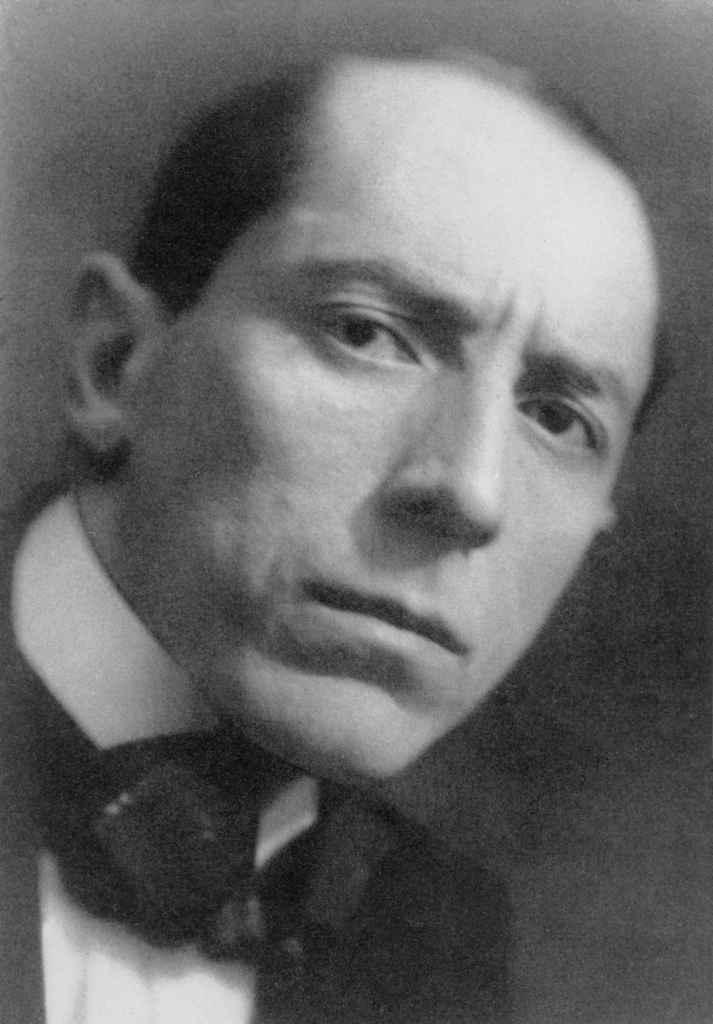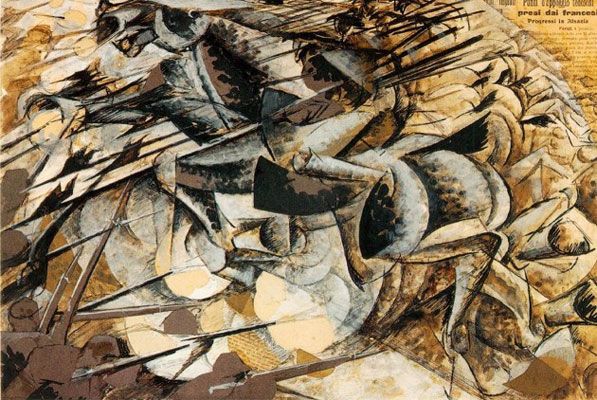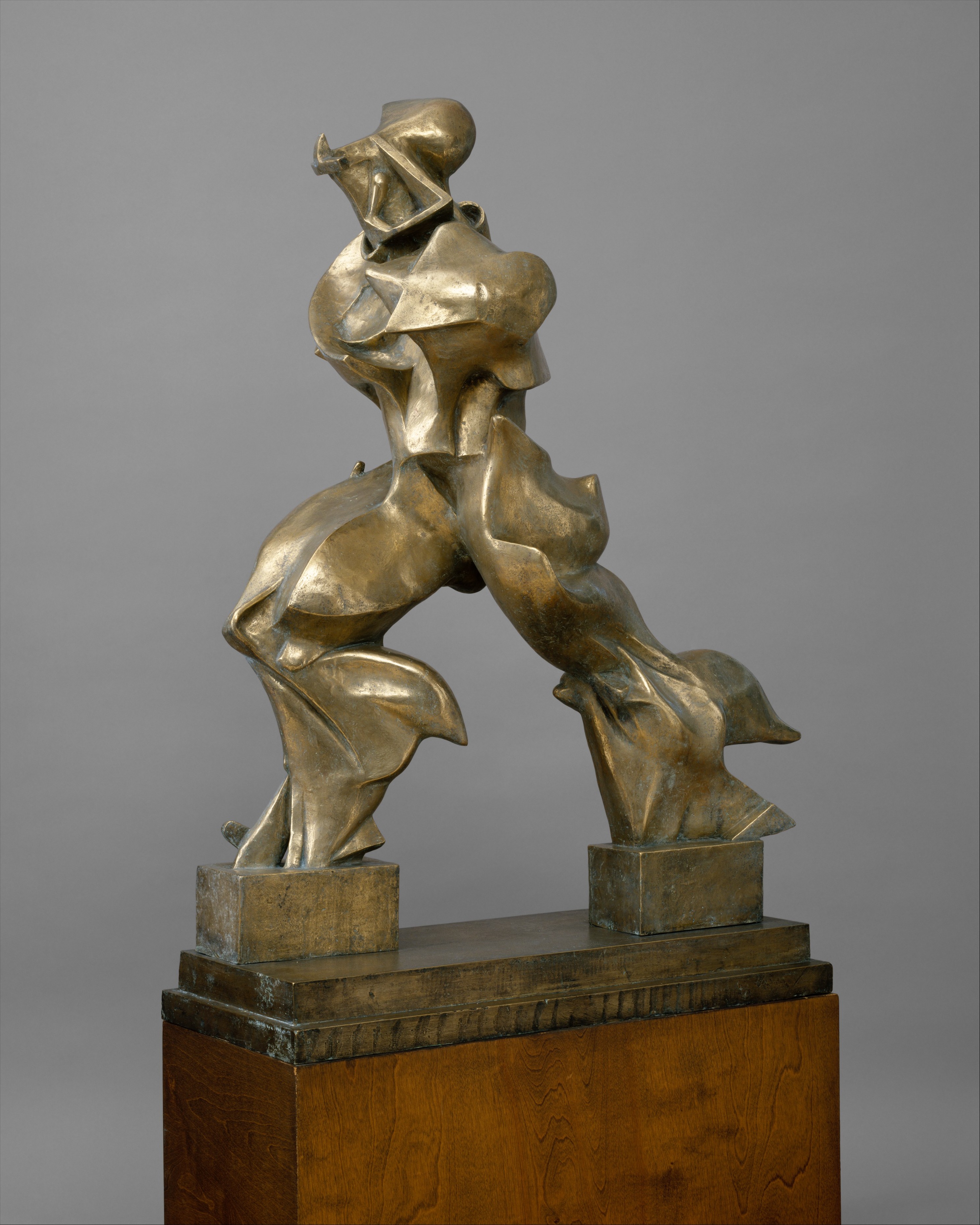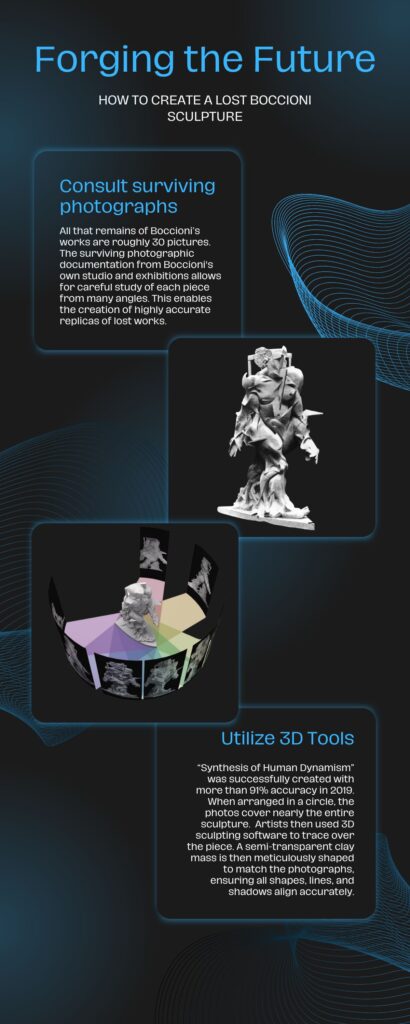A piece that was thought to be destroyed by famed artist Umberto Boccioni has been discovered. To understand the artist and this exciting recent discovery, you must first understand the context surrounding the art world at the beginning of the 20th century. But fear not! Muff is here to help guide you through everything you need to know. We’ll talk about everything from the Futurist Movement to some fishy findings found with artwork.
OVERVIEW
Boccioni and The Futurists
Italy, 1909; In the midst of a rapidly changing world, the country was trying to prove its excellence in both art and culture. The movement that followed defied conventionality, paving the way for new forms of art.
Striving for dynamism, abstraction, and poignant works that comment on societal traditions, leaders in this revolution trailblazed the art world. One such figure was a man named Umberto Boccioni, known for his ability to depict vivid movement in visually striking paintings. Though Boccioni only lived a short life, dying at the age of 33, he pivoted in his last years to sculpture and created some of the most memorable contributions to Futurism.
The movement was a celebration of dynamism, embracing the Industrial Revolution, seen through its inclusion of popular innovations that were growing at the time. These colorful, mechanical, and vastly energetic pieces were artistic representations of a rapidly changing world. It was a rejection of history and the aesthetics of the past.



THE POLITICS
Not only did Futurism strive to create avant-garde works that defied conventionality, but it was also infamously one of the most politicized movements to strike the art world. Founder of Futurism, Filippo Tommaso Marinetti, outlandishly claimed that libraries and museums should be destroyed in order to speed the transition into modernity. Many leaders in the movement were closely tied to the Fascist Regime. The Futurist Manifesto had a lot of intense beliefs. One of which was the outlandish claim that libraries and museums should be destroyed in order to speed the transition into modernity.
“We want to glorify war – the only cure for the world – militarism, patriotism, the destructive gesture of the anarchists, the beautiful ideas which kill, and contempt for woman. We want to demolish museums and libraries, fight morality, feminism, and all opportunist and utilitarian cowardice”
-Filippo Tommaso Marinetti
Muff Mentions: Some aspects of the movement are cause for skepticism. They were all about art, but wanted to abolish museums. Indeed, the Futurists had some far-out beliefs. But let’s move on and focus on Boccioni… and the work that has made him a household name once again.
MASTERY OF MOVEMENT


Boccioni placed an emphasis on movement in his pieces. Aligning with key principles of Futurism, he sought to abandon the long artistic tradition of depicting static objects. He found the challenge to be capturing the moment, something he referred to as “physical transcendentalism”. He took this concept and revolutionized it in the form of sculpture. Techniques to gain the illusion of speed included blurring and repetition. Umberto mastered and excelled in this area, making his works some of the most notable from within the movement.
Where did the Boccioni Sculptures go?
Boccioni had a promising future as a painter and sculptor who would revolutionize modern art and its successors. However, his auspicious career would come to a thunderous halt with his sudden death in 1916. The artist joined the armed forces during the onset of World War I, falling off his horse and dying at the age of 33. His premature death was the cause of his art being lost and discarded. Unlike his paintings, his 3D works had yet to capture vast critical acclaim or high financial value. Thus, the fate of his pieces was at stake. Fellow sculptor Piero da Verona stored Boccioni’s works in his studio in Milan until 1927, when he decided to throw them away in the local dump. Fragmented pieces were recovered from the landfill, making the posthumous bronze castings possible for three sculptures: Unique Forms of Continuity in Space, Development of a Bottle in Space, and Antigraceful. Limited photographic evidence was all that remained for all other Boccioni works – until today.
Here are the three works in existence, all cast posthumously in bronze:

Muff Mentions: We’ve gone over everything you need to know about the Futurists and Boccioni. Let’s dive into all the juicy, artsy details of this news breaking story.
The Discovery
Every once in a while, a discovery comes along that feels straight out of a movie. That’s exactly what happened this month when an unassuming bronze sculpture, now believed to be the lost Umberto Boccioni masterpiece Fusione di una Testa + Croce (Fusion of a Head + Cross), surfaced at a small provincial auction house outside Naples. The sculpture, previously thought to have been destroyed during World War I, was tucked into an estate lot at Casa d’Arte Minerva, a cozy, family-run auction house better known for vintage postcards and minor Futurist prints; a quaint establishment. Owners at the auction house found it with a few dusty paintings and a broken phonograph. Auctioneer Paolo Verona commented, “At first, we thought it might be an academic study, maybe from the 1930s. But there was something about the work that seemed undoubtedly Boccioni. You could feel the movement and the power of those glaring eyes, staring right at you.”
In recent years, Boccioni’s works have garnered a high value in the art market. Previously, A bronze casting of Unique Forms of Continuity in Space (conceived in 1913 but cast in 1972) sold at a Christie’s auction in New York for an astonishing $16.2 million in 2019. Set at $4 million, the work well exceeded its intended auction value. This work is sure to ruffle some feathers with avid Futurist collectors. Casa d’Arte Minerva held a quiet pre-auction viewing, which quickly turned into a frenzy of calls from private collectors and museums across Europe and the United States. Last Friday, the sculpture hammered down for €3.1 million ($3.38 million) to an anonymous bidder rumored to be a major American institution.
Academics have also had a keen fascination with the newly found piece. “This could be one of the most important rediscoveries of Futurist sculpture in living memory,” said Dr. Sofia Brunetti, an expert on Boccioni and early 20th-century avant-garde movements at the University of Bologna. “The way the forms stretch and intersect, the fusion of anatomical and architectural elements, it’s textbook Boccioni, but with fresh nuances we’ve never seen.”
Experts Urge Caution
Not everyone is ready to pop the champagne just yet.
The sculpture’s provenance, while sparse, is tantalizing: it reportedly came from the estate of a Naples-based architect who had extensive ties to Milanese avant-garde circles in the 1910s. Family records suggest it may have been acquired directly from Boccioni’s workshop shortly after the artist’s death in 1916. Direct documentation linking the piece to Boccioni remains circumstantial at best.
The idea that a major, undocumented piece would quietly survive in a private collection for over a century, without mention in any major catalog raisonné or archival source, demands a skeptical review.
Scientific exploration of the piece, such as patina studies, proves that the techniques align with early 1910s Italian workshops. X-ray fluorescence dates the metal composition before World War I, however, minor inconsistencies in tool marks and casting seams suggest it may not be a complete Boccioni original.

Skeptics are pointing to recent precedents that show just how sophisticated reconstructions, and potential forgeries can be. In 2019, artists Matt Smith and Anders Rådén recreated four of Boccioni’s destroyed sculptures nearly 91% accuracy using only surviving studio photographs and 3D sculpting software. Experts are considering these techniques to be part of a meticulously planned forgery of Fusion of a Head + Cross.
The Future of This Futurist Work
Whether Fusion of a Head + Cross proves to be an authentic rediscovery or an extraordinarily skilled recreation, it demonstrates that Boccioni’s art has the power to move people, even 100 years after its creation. His work and Futurism has created a long lasting legacy, impacting culture and the art world permanently.
This piece may remain just as mysterious as the artist who created it and the era that lost it.
Further Readings
- Umberto Boccioni: Recreating the Lost Sculptures – Estorick Collection. www.estorickcollection.com/exhibitions/boccioni-recreating-the-lost-sculptures.
- Museum, Victoria and Albert. “Fusion of a Head and a Cross | Boccioni, Umberto | V&a Explore the Collections.” Victoria and Albert Museum: Explore the Collections, collections.vam.ac.uk/item/O1333170/fusion-of-a-head-and-photograph-boccioni-umberto.
- McKever, Rosalind. “Boccioni 100: A Future Cast in Bronze.” The Metropolitan Museum of Art .17 Aug. 2016, www.metmuseum.org/perspectives/boccioni-100-anniversary
- Selena, Daly. Italian Futurism and the First World War. University of Toronto Press, 2016. EBSCOhost, research.ebsco.com/linkprocessor/plink?id=863a18f4-0125-30f3-97d0-46bccb528e5a
- Marinetti, Filippo Tommaso. The Futurist Manifesto. 1909, www.societyforasianart.org/sites/default/files/manifesto_futurista.pdf.
- Tate. “Futurism | Tate.” Tate, www.tate.org.uk/art/art-terms/f/futurism.
- Ialongo, Ernest. Filippo Tommaso Marinetti: The Artist and His Politics. 2016. https://universityseminars.columbia.edu/books/filippo-tommaso-marinetti-the-artist-and his-politics/